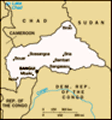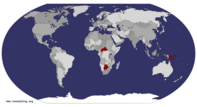Advertisement
Published: December 13th 2014
The armed coup has occured in the CAR, Fights with the rebelts in the capital... and the plane with a group of desperate travelers are landing at the airport. "Isn't that all?! Flied off... "
The crew is lowering the ramp, we are being met by a military escort on he land. The level of adrenaline in the blood is going off scale. I feel the pulsing artery under the cerebral cortex.We are being taken away for questioning. In a small stuffy room the representative of the interim government of the country begins to fulfill his duties. All the furniture in a shabby room consists of a table and two chairs. The expected questions: " Who are we? What are we doing in the CAR? What is the purpose of our visit? What are we looking for? What political interests do we pursue? Are we sponsoring any radical group?"
Making sure that we are just unlucky tourists who found themselves at the wrong time and the wrong place, the officer takes us back to the runway. It turned out that Rod Cassidy, the owner of Sangha Lodge, the place where we have to live, after having learnt about the
impending coup and anticipated these events, sent his friend-pilot to us on a small Caravan Sessna. It is even difficult to imagine what riches he promised to Rod for such a dangerous mission into the capital of the blaze. Nevertheless, it has worked, and we continue our journey.
Under the wing of our airplane a green carpet of impassable jungle are spreading... The landscape consists of low hills and lowlands covered with fog. Just remember the movie "Gorillas in the Mist." It is the environment and the home for western lowland gorillas. According to some reports a little more than three thousand individuals live in the national park Dzanga-Sangha . However there is another information that there are no more than 480 individuals there. In my opinion, this figure is greatly reduced.
In comparison with their mountain relatives lowland gorillas are smaller, have longer forelimbs, a broad face and brown-gray color of the fur. Males are much larger than females, their growth reaches up to 180 cm and weight can be up to 270 kg. Most of their time the gorillas spend on the trees where their favorite fruits grow, and at night they prefer to go down
to the ground. Western lowland gorilla as well as its congener - the mountain gorilla is an endangered specie. In the CAR these primates have survived only in the south-west of the country, in the Dzanga-Ndoki and Dzanga-Sangha reserve- the very places where we are heading our way.
Finally our small but very reliable aircraft is landing on the tiny runway. It is very hot and humid outside. We were met by a smiling Rod Cassidy. This is a man of 60 years old, with a cute face, a long beard and long gray hair. Whether a kind smile or his whole appearance of a forest dweller man instantly endear to him the feeling of anxiety goes away and finally we are able to relax.
We loaded the luggage in the old land Cruiser and started our way to the temporary home. The way isn't short and leads right through the dense virgin forests. The road is bumpy and washed away by the rains, its endpoint is a flooded area where we are forced to leave the car and stay on a handmade raft with a help of a rope slowly to reach the promised shore.
"House"
I must say that the lodge was quite simple. The houses were knocked together from the wooden planks, the roof is made of dried palm leaves. No air conditioning. All the furniture of the room is a bed, covered with a mosquito net, a table, a chair, a toilet and a washbasin. With the help of a very primitive construction, the water is supplied to the shower directly from the river. All structures are absolutely identical except for Rod's family house. This hut is filled with all sorts of cozy small things as our hospitable host, friendly, fragile woman Tamar, charming Tali and reliable Alon - live in Sangha Lodge all year round. Very specific business in the area, but a brave man risked everything, having exchanged a comfortable life in South Africa at a very alarming in the CAR.
On our first day we saw the lowland gorillas - they came very close to the lodge. In general the nature together with the Sangha Lodge exist almost in symbiosis. The Forest hotel is located near the river in the impenetrable thicket far from large cities. People here just can not be found! Large and small primates, forest
elephants, various artiodactyls, armadillos, porcupines, all kinds of reptiles, bats and rodents. I immediately found the small ones in the house. The first morning when I went to brush my teeth a tiny mouse hung directly on the neck of an open bottle of water. But unfortunately not only mice were my neighbors. The walls of the hut were full of huge spiders in the evenings. Despite of the fact that these spiders are completely harmless to a man they look far from the harmless ones.
Ba'aka
Also that day we went to get acquainted with the Pygmies ba'aka. I must say that the pygmies - the most undersized people on the Earth, their average height is only 140 cm. Pigmaios, in Greek it means "the size of a fist." The absolute majority of pygmies live in sub-Saharan Africa.
"Pygmies" is a general term for all "forest people" in the region although they are divided into several ethnic groups and each tribe has its own rituals, beliefs, culture and even its own language. In the Central African Republic you can meet Pygmies akoola, akova, babongo, ba'aka, bakoya and bakuyn. I arrived here to meet ba'aka. These small
"forest people" are unique because of their folklore - songs and dances in which they talk about their daily life, hunting, the world around them. Unlike other related groups ba'aka preserved their native language.
Small "forest people" live by hunting and gathering. But some of them who live in the vicinity of Bayangi even have small vegetable gardens where they grow cassava. Cassava is a shrub, also known as yucca - is one of the most important crops in Africa. Only roots are used in food which look like our potatoes. Moreover, in its raw form, they are highly toxic and are used only after the heat treatment. They cook porridge, bake bread and cakes out of cassava flour.
People Ba'aka - very good hunters and we by the way were soon convinced in it. For many centuries they lived in the woods and near the settlements of Bantu tribes. There was always a trade exchange between them. Pygmies hunted meat of wild animals and other forest products and in return they received the necessary goods. However over the past 50 years the situation has changed dramatically. Since the roads appeared in this area and the logging companies
began their work many Bantu people rushed to work in the forest. Now they hunt for the forest bushmeat, thereby forcing ba'aka cultivate their own vegetable gardens and earn money to buy cassava, tobacco and other things necessary for their needs.
Pygmies have to spend out of the forest more and more time. Despite the fact that the older generation still returns to the green forest area, young people prefer to live in towns and villages, because every person aspires to a better life and very often wealth displace spiritual values. Thus there is an integration of the tribe in a civilized society. Moreover it is not too long to wait when the last ba'aka gone out of the woods forever. Unfortunately, this is a problem and the fate of all existing tribes.
Recently the relations between ba'aka and Bantu have significantly deteriorated but the "forest people" hope for a peaceful outcome to the conflict. Ba'aka would be completely exposed to the future and the neighbors, if Louis Sarno wasn't interested in them - brilliant American scholar and author of several books, since mid 80s living among the Pygmies in the Central African Republic. He recorded a huge
amount of records with the voices of the people of this nation and was honored to be one of the ba'aka having the opportunity to marry a local woman and adopt some children. In an official interview Louis talked about what led him to a mysterious and frightening Africa: "One winter night I turned on the radio station of the Netherlands and heard a song that literally hypnotized me. I've never heard anything like it! Melody that catches, leads somewhere and will not be returned ... This exotic music was pure magic. It led me to follow it, in the heart of Africa. I wanted to record these sounds by myself. "Louis said that from his childhood his dream was to live in the rain forest, he was always interested in insects and reptiles. He is very happy among people ba'aka. By calling attention to the music and the ba'aka's problems, Louis Sarno helps to preserve the material and spiritual culture of the tribe, and his long-term work is an invaluable contribution to the ethnography.
Louis Sarno lives a very simple life without any frills, wears shabby clothes, eats the same food as the members of the tribe. Initially
I was shocked by the life of Louis, I was wondering how a white American, highly educated and well-read person can exist in the same conditions as illiterate black men in the tribe. During my travels I often meet scientists from all over the world, working with different ethnic groups but as a rule they do not live in the tribe and wear clean clothes and enjoy the benefits of civilization. All this is radically different from the way of the life of Louis Sarno. But the more time I spent in his company, the better I could understand him. Louis is a man of great heart, he is sincere in his love for the BA aka. The study of the BA aka tribe is not only the business of his life, this is his very life. All the money that he earns on the distribution of books, records, attraction of tourists, Louis spends on the needs of the tribe. That is why he lives very simply realizing that all the most valuable and necessary things for his happiness he has already had, and all the rest is completely unnecessary product of modern civilized society, which depends on many completely
stupid things, clogging consciousness and leading away from the true human values.
Louis invited us to take part in the hunt along with the BA aka and we were very happy . Speaking all day and all night with such a brilliant scientist we apparently got his light energy, and now also sincerely wanted to feel ourselves as a part of this ethnic group.
And here we are loading in three jeeps cheering by songs of the members of the tribe. Five of us as the most important guests, take two cars, and about 35-40 BA aka start to get into the pickup Toyota Land Cruiser. Wow! Almost all fit in one car! During my student days despite of all our efforts only seven people could fit in the car "Volga". And here's a funny compactness and complete violation of the laws of physics!
Advertisement
Tot: 0.144s; Tpl: 0.013s; cc: 7; qc: 76; dbt: 0.0665s; 1; m:domysql w:travelblog (10.17.0.13); sld: 1;
; mem: 1.3mb

















